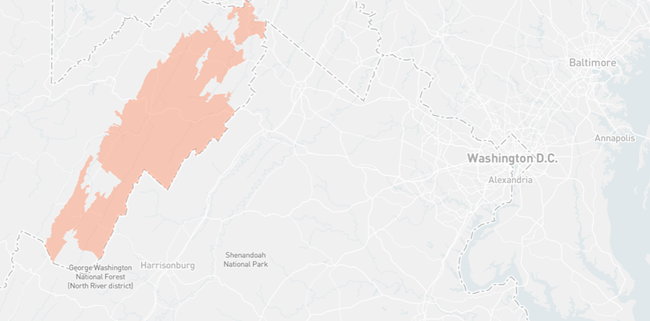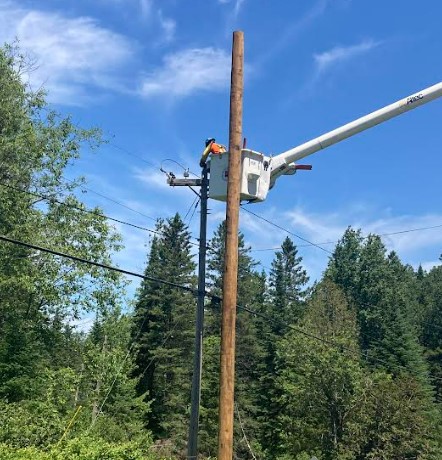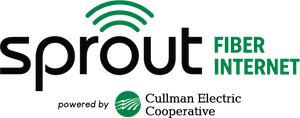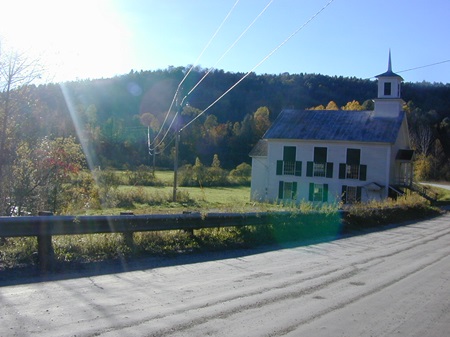
Fast, affordable Internet access for all.

The rocky rural hills of West Virginia are a formidable foe when it comes to building high-speed Internet infrastructure that offers affordable high-quality service.
Nobody knows that better than Hardy Telecommunications (OneNet), a small community-owned cooperative that delivers affordable fiber to frustrated locals deemed too costly and cumbersome to be served by the incumbent telecom giants.
The cooperative serves parts of four counties (Hardy, Pendelton, Grant, and Hampshire). It connected its first fiber customer in 2013, after receiving $31.6 million in federal BTOP funding. Since then, the cooperative tells ILSR they’ve spent $20 million of their own funds to bring fiber to rural corners of the aptly-named Mountain State.
Derek Barr, Assistant General Manager at Hardy Telecommunications, says the cooperative currently delivers broadband service to 5,050 rural subscribers – 4,736 of which are on fiber lines that simply wouldn’t exist without federal funding programs. Hardy Telecommunications also provides 68 customers with fixed wireless access (FWA) broadband service.

“Our focus is fiber, and we're trying to build out fiber as much as we can,” Barr tells ILSR. “But it's very tough in our serving region. It's all mountains and a lot of trees, and a big chunk of our area is either state park or national forest land. It's also very hard to do fixed wireless because even if it might work in the winter, it's not going to work in the summer” when tree leaves block line of sight, he noted.
So the cooperative slowly and consistently expands fiber as it can, often in partnership with Pendleton County. As a result, locals have the option of a variety of double and triple play phone, cable, and fiber options, starting with a symmetrical 100 Mbps (megabit per second) downstream, 50 Mbps upstream fiber and phone bundle for $79 a month.
Officials in Washoe County, Nevada have struck a new public private partnership (PPP) with Digital Technology Solutions (DTS) to deploy affordable fiber service into the long-neglected rural towns of Gerlach and Empire, Nevada. The deal is part of a broader effort to bring affordable access to underserved residents just out of reach of broadband access.
Behzad Zamanian, Washoe County Chief Information Officer, tells ILSR that the county’s two-phased project first involved contracting with DTS to construct and maintain a $2.3 million middle-mile fiber network that connected Gerlach to Reno, culminating in a ribbon-cutting ceremony at the Gerlach Community Library last July.
“The reason [Gerlach] was identified as a high priority was that it was considered unserved or underserved; there was no presence of any of the major Internet service providers in that region,” he noted. “There was no high speed Internet available.”
Until last summer, area students and residents were completely cut off from online learning, employment services, remote health care, and other essential services and opportunities.
Expanding the middle mile network required close collaboration with the Pyramid Lake Paiute Tribe, which allowed the county to piggyback on the tribe’s existing fiber runs from Reno to Nixon, Nevada. The county then worked closely with the Nevada Office of Science, Innovation, and Technology (OSIT) and DTS to deploy fiber the remaining 60 miles from Nixon to Gerlach.
Alabama has announced the release of $148.3 million in new broadband grants via the state’s Capital Projects Fund (CPF), made possible by the 2021 American Rescue Plan Act (ARPA). While regional monopolies like Charter nabbed the lion’s share of state funding (once again), cooperatives also secured significant funding to tackle the rural digital divide.
“High-speed internet service continues to strengthen and expand across the state, and we are taking the necessary strides on this journey to achieve full broadband access for Alabama,” Alabama Governor Kay Ivey said in a prepared statement. “This has been a monumental task, but it is one that will pay multiple dividends for our state and its residents. Today is an exciting day as we announce these latest projects.”
Cable giant Charter Communications (Spectrum) was the biggest winner of state funds, awarded 23 grants totaling $44.8 million to shore up access to 22,000 underserved homes across 25 Alabama counties. The next biggest award recipient was Mediacom, which received $22.8 million in grants to fund deployment to 8,000 homes across six Alabama counties.

All told, 16 providers were awarded grants to expand access to 48 different Alabama counties. While regional monopolies were heavily represented in the awards, four different Alabama cooperatives received $34.8 million in grant funding to expand fiber access to more than 11,092 rural Alabama homes and businesses.
NEK Broadband continues to bring affordable fiber access to the long-neglected corners of the Green Mountain State. According to the latest update by NEK Broadband, a recently completed rollout has delivered affordable fiber access to 700 new addresses across multiple rural Vermont communities.
NEK Broadband is one of nine Communications Union Districts (CUDs) scattered across the state of Vermont. NEK Broadband alone represents 45 Vermont communities across Caledonia, Essex, Orleans and Lamoille Counties in the northeast part of the state (see the full list of communities here).
The CUD’s latest expansion plan primarily focused on bringing fiber access to parts of Danville, Kirby, Lyndon, St. Johnsbury, Walden and Wheelock, Vermont. With this latest expansion, NEK Broadband now provides fiber access to 2,100 predominantly rural Vermont residents in total, many of which only received broadband for the first time last year.
“We’re so pleased to end 2023 by giving more residents of the NEK access to high-speed internet,” Christa Shute, NEK Broadband’s Executive Director, said in a prepared statement. “We plan to bring even more residents online in early 2024.”

The CUD currently provides upgraded users with access to speeds that exceed those provided by cable and DSL providers, even in many more urban markets.
NEK Broadband currently offers four tiers of broadband service: symmetrical 50 megabit per second (Mbps) service for $80 a month; symmetrical 250 Mbps service for $103 a month; symmetrical 500 Mbps service for $135 a month; and a symmetrical gigabit per second (Gbps) offering for $250 a month.

Join us Tuesday, January 16th at 2pm ET for the latest episode of the Connect This! Show. Co-hosts Christopher Mitchell (ILSR) and Travis Carter (USI Fiber) will be joined by regular guests Doug Dawson (CCG Consulting), Kim McKinley (UTOPIA Fiber), and special guest Roger Timmerman (Executive Director UTOPIA Fiber) to prognosticate all of the broadband things for 2024: will ACP get renewed? Which states will get BEAD right, and which are showing signs of cracking under the pressure? What did we see at CES that will impact the broadband market? Is the fiber market going to pause? Tune in for titillating discussion on these topics and many more.
Email us at broadband@communitynets.org with feedback and ideas for the show.
Subscribe to the show using this feed or find it on the Connect This! page, and watch on LinkedIn, on YouTube Live, on Facebook live, or below.
Cullman, Alabama-based Cullman Electric Cooperative says it is launching a new phase of fiber deployment after receiving a $7 million grant to bring affordable fiber access to long-neglected Cullman and Winston counties.
The financing was made possible by the Alabama Broadband Accessibility Fund (ABAF), funded by the 2021 American Rescue Plan Act (ARPA). The state has already dedicated more than $82 million in funding for Alabama broadband deployments, bringing broadband access to 72,000 currently unserved residents.

Cullman’s $7 million portion will bring affordable fiber access to 1,300 families. Known as Sprout Fiber Internet, Cullman currently offers residential customers symmetrical 300 Mbps (megabit per second) service for $60 a month; symmetrical 1 Gbps (gigabit per second) service for $80 a month, and symmetrical 2 Gbps service for $120 a month.
That’s significantly faster and cheaper service than is currently offered by any of the dominant private telecom monopolies in Cullman (predominantly AT&T or Charter/Spectrum), without usage caps, hidden fees, or long-term contracts.
After decades of failed broadband policy-making and incumbent provider neglect, many Tribal communities continue to lack affordable and reliable Internet connectivity. Limited access to capital for last-mile deployment on Tribal lands has been exacerbated by a vast “missing middle mile” problem, and credible estimates put the costs of universal access on reservations at well over $10 billion.
Despite a historic investment in better Internet access from the federal government directly to Tribes, the problem is not even half solved. The first round of the Tribal Broadband Connectivity Program offered $2 billion in grants but received nearly $6 billion in requests from half of the 574 federally-recognized Tribes. With only $1 billion available in the final round of this program, an enormous funding gap remains.
Funding from the Broadband Equity, Access, and Deployment Program (BEAD) will have to be used strategically and collaboratively with Tribes to bridge this gap. The “high-cost area” match exemption could be an important tool to facilitate sustainable infrastructure deployment on Tribal lands, but it is not yet clear that states will make this exemption feasible.
First Electric Cooperative – and its broadband subsidiary Connect2First – are making major inroads on their quest to deliver affordable fiber Internet service to long-neglected portions of Arkansas.
Buoyed by an historic stretch of federal funding, the cooperative says it’s on target to deliver up to 2.5 gigabit per second service to 72,000 locations by the end of 2024.
Connect2First officials say they’ve deployed 4,371 miles of fiber across 18 counties in the southeastern part of the state, just outside of the state capital in Little Rock, delivering speeds significantly higher than seen in more urban, populous areas. The resulting service is also a notable step up in speed from regional monopolies like AT&T and Optimum, which see little market incentive to upgrade lagging networks or compete on price.
Connect2First residential customers have the choice of three tiers of service: a symmetrical 200 megabit per second (Mbps) connection for $60 a month; a symmetrical 700 Mbps connection for $60 a month; or a symmetrical gigabit per second (Gbps) service tier for $100 a month. The company’s tiers feature no service caps, hidden fees, or long term contracts.

First Electric Cooperative, headquartered in Jacksonville, Arkansas, began in 1938 with just 3 employees and 150 members. Now with 94,000 electricity customers, it’s one of the largest cooperatives in the country, and the second biggest cooperative in the state of Arkansas.
CVFiber continues to make progress in deploying affordable fiber to long-neglected rural areas in Vermont, as the state’s effort to embrace CUDs (Communications Union Districts) as a cornerstone of bridging the digital divide also pays dividends.
In late 2022 CVFiber broke ground on an ambitious plan to build a 1,200-mile fiber-optic network to bring affordable gigabit broadband access to 6,000 rural Vermont addresses deemed underserved by commercial broadband providers.
According to an October announcement by the CUD, its first customers have been connected in the central Vermont town of Calais, with construction ongoing in nearby Middlesex, East Montpelier, and Worcester.

“We are enthusiastic about our progress as we bring high-speed Internet to central Vermont communities,” CVFiber Executive Director Jennille Smith said. “The progress that we have made and the impact that we’ve been able to achieve to date could not have been accomplished without the unwavering commitment from our partners. We are optimistic as we expand to other service areas.”
CUDs have proven to be a useful way for municipalities to band together to cooperatively build broadband projects that may have been financially and logistically impossible to try alone. Vermont CUDs can legally fund needed broadband expansions through debt, grants, and donations—but not taxes, though they themselves are tax-exempt nonprofits.
CVFiber’s fiber deployment is expected to cost $60 million, $27 million of which is being paid for by federal grants made possible by the American Rescue Plan Act (ARPA). The remaining cost is expected to be funded by network revenue, loans, and future grant opportunities.
A new chapter in state-Tribal relations is being written as the importance of robust and reliable telecommunication becomes all-too-apparent, especially in the face of more frequent extreme weather events. For the first time, a Tribe in California is building high-speed Internet infrastructure in collaboration with the state, thanks to the resilience of the Hoopa Valley people.
Tucked along the Trinity River in the northwestern corner of the state, the Hoopa Valley Reservation is located in a rural and heavily wooded region that spans over 89,000 acres, home to over 2,500 Tribal citizens. Last summer, the area was ravaged by closely-timed wildfires and thunderstorms, followed by massive landslides that collapsed into the region’s riverways, including the Trinity River, a sacred body of water for the Hoopa Tribe.
As the river turned to mud and dead fish began to wash up on its banks, alarmed residents had limited means of connecting with one another, getting timely information about what was going on, or contacting emergency services. That was because of a hidden casualty of the wild weather: the Tribe’s wireless Internet network, which sustained severe damage that not only hindered communication but also extended the time it took to assess the damage.